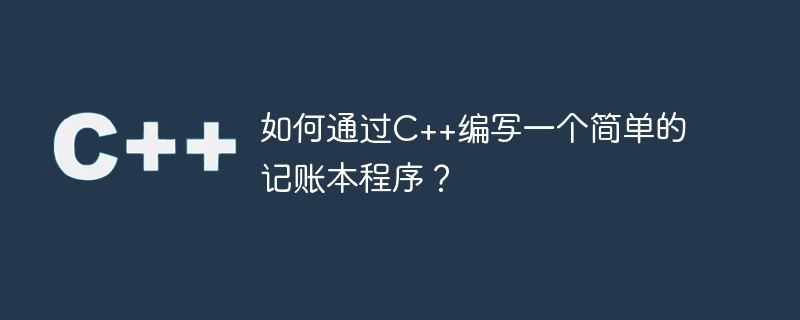C++ で簡単な会計プログラムを作成するにはどうすればよいですか?

この記事では、C を使用して簡単な会計プログラムを作成する方法を紹介します。台帳を使用すると、収入と支出を記録し、財務管理スキルを向上させることができますが、C 言語の利点はその効率性と移植性であり、このようなプログラムの作成に非常に適しています。
1. プログラムの機能と要件を決定する
プログラムを書く前に、まずプログラムで実現したい機能と要件を明確にする必要があります。単純な家計簿プログラムでは次のものが必要です。機能:
(1) 各支出と収入の金額と種類、時刻を記録できる;
(2) 含む全体の収入と支出を計算できる収入と支出の合計数;
(3) レポートを作成し、各タイプの支出と収入の合計をカウントする機能;
(4) 追加、削除、変更、確認する機能記録。
- データ構造とアルゴリズムの設計
プログラムでは、データ構造を使用して各レコードを保存する必要があります。一般的に使用されるデータ構造には、線形テーブル、スタック、キュー待機が含まれます。ここでは、線形テーブルを使用して各レコードを保存することを選択します。各レコードには次の情報が含まれます:
(1) レコードの一意の ID 番号;
(2) レコードのタイムスタンプ記録;
(3) 収入と支出を含む記録の種類;
(4) 記録金額;
(5) 記録の詳細。
アルゴリズムについては、追加、削除、更新、クエリ、統計などのさまざまな操作を実装する関数を設計する必要があります。これらの操作には、記録されたデータへのアクセスが必要であり、総収益と計算も必要です。支出とタイプの分類を合計し、対応するレポートを生成します。
- コードの記述
コードを書き始める前に、次のような準備をする必要があります。
(1) 統合開発環境を選択する ( IDE)、Visual Studio など;
(2) 基本的な C 構文を学習し、プログラミングに STL ライブラリを使用します;
(3) プログラムのクラスと関数を設計します。
C では、クラスを使用して会計プログラムを表すことができます。このクラスには、さまざまなメンバー関数とメンバー変数、および対応するアクセス制御文字を含めることができます。
次は、単純な会計プログラムのコード例です。
#include <iostream>
#include <vector>
using namespace std;
class Record {
public:
int id;
string date;
string type;
double amount;
string description;
Record(int _id, string _date, string _type, double _amount, string _description) {
id = _id;
date = _date;
type = _type;
amount = _amount;
description = _description;
}
};
class AccountBook {
public:
vector<Record> records;
void addRecord(int id, string date, string type, double amount, string description) {
records.push_back(Record(id, date, type, amount, description));
}
void deleteRecord(int id) {
for (vector<Record>::iterator it = records.begin(); it != records.end(); it++) {
if (it->id == id) {
records.erase(it);
break;
}
}
}
void updateRecord(int id, double amount) {
for (vector<Record>::iterator it = records.begin(); it != records.end(); it++) {
if (it->id == id) {
it->amount = amount;
break;
}
}
}
void searchRecords(string type) {
for (vector<Record>::iterator it = records.begin(); it != records.end(); it++) {
if (it->type == type) {
cout << "ID: " << it->id << endl;
cout << "Date: " << it->date << endl;
cout << "Type: " << it->type << endl;
cout << "Amount: " << it->amount << endl;
cout << "Description: " << it->description << endl;
}
}
}
void generateReport() {
vector<double> income(5, 0);
vector<double> expense(5, 0);
for (vector<Record>::iterator it = records.begin(); it != records.end(); it++) {
if (it->type == "Income") {
income[0] += it->amount;
if (it->description == "Salary") income[1] += it->amount;
else if (it->description == "Bonus") income[2] += it->amount;
else if (it->description == "Investment") income[3] += it->amount;
else if (it->description == "Gift") income[4] += it->amount;
}
else if (it->type == "Expense") {
expense[0] += it->amount;
if (it->description == "Food") expense[1] += it->amount;
else if (it->description == "Clothing") expense[2] += it->amount;
else if (it->description == "Housing") expense[3] += it->amount;
else if (it->description == "Transportation") expense[4] += it->amount;
}
}
cout << "Total income: " << income[0] << endl;
cout << "Salary: " << income[1] << endl;
cout << "Bonus: " << income[2] << endl;
cout << "Investment: " << income[3] << endl;
cout << "Gift: " << income[4] << endl;
cout << "Total expense: " << expense[0] << endl;
cout << "Food: " << expense[1] << endl;
cout << "Clothing: " << expense[2] << endl;
cout << "Housing: " << expense[3] << endl;
cout << "Transportation: " << expense[4] << endl;
}
double calculateBalance() {
double income = 0, expense = 0;
for (vector<Record>::iterator it = records.begin(); it != records.end(); it++) {
if (it->type == "Income") {
income += it->amount;
}
else if (it->type == "Expense") {
expense += it->amount;
}
}
return income - expense;
}
};
void printMenu() {
cout << "1. Add record" << endl;
cout << "2. Delete record" << endl;
cout << "3. Update record" << endl;
cout << "4. Search records" << endl;
cout << "5. Generate report" << endl;
cout << "6. Calculate balance" << endl;
cout << "7. Quit" << endl;
}
int main() {
AccountBook accountBook;
int choice;
while (true) {
printMenu();
cout << "Enter your choice: ";
cin >> choice;
if (choice == 7) {
cout << "Goodbye!" << endl;
break;
}
switch (choice) {
case 1: {
int id;
string date, type, description;
double amount;
cout << "Enter ID: ";
cin >> id;
cout << "Enter date (YYYY-MM-DD): ";
cin >> date;
cout << "Enter type (Income/Expense): ";
cin >> type;
cout << "Enter amount: ";
cin >> amount;
cout << "Enter description: ";
cin >> description;
accountBook.addRecord(id, date, type, amount, description);
cout << "Record added." << endl;
break;
}
case 2: {
int id;
cout << "Enter ID: ";
cin >> id;
accountBook.deleteRecord(id);
cout << "Record deleted." << endl;
break;
}
case 3: {
int id;
double amount;
cout << "Enter ID: ";
cin >> id;
cout << "Enter amount: ";
cin >> amount;
accountBook.updateRecord(id, amount);
cout << "Record updated." << endl;
break;
}
case 4: {
string type;
cout << "Enter type (Income/Expense): ";
cin >> type;
accountBook.searchRecords(type);
break;
}
case 5: {
accountBook.generateReport();
break;
}
case 6: {
cout << "Balance: " << accountBook.calculateBalance() << endl;
break;
}
default: {
cout << "Invalid choice." << endl;
break;
}
}
}
return 0;
}- テスト プログラム
コードの作成が完了したら、次のコードをテストする必要があります。プログラムがテストを実行します。プログラムをテストするための具体的な方法は次のとおりです:
(1) データと操作 (追加、削除、更新、クエリ、レポートなど) を入力します;
(2) プログラムが正常に動作するかどうかを確認します。正しい結果が出力されます ;
(3) プログラムが正常に終了できるかどうかを確認します。
テスト中に、プログラムの正確性と安定性を確保するために、さまざまなデータを使用してテストすることができます。プログラムに問題が見つかった場合は、コードを変更してデバッグする必要があります。
- 概要
この記事では、C を使用して簡単な会計プログラムを作成する方法を紹介します。これには、プログラムの機能と要件の決定、データ構造とアルゴリズムの設計、コードの記述とテストが含まれます。プログラム。このプログラムには、残高の追加、削除、更新、クエリ、レポート、計算などの機能があり、人々が自分の財務状況をより適切に管理するのに役立ちます。この記事の内容を学ぶことで、C言語の応用やプログラミングの基本的な手法についての理解を深め、プログラミングスキルを向上させることができます。
以上がC++ で簡単な会計プログラムを作成するにはどうすればよいですか?の詳細内容です。詳細については、PHP 中国語 Web サイトの他の関連記事を参照してください。

ホットAIツール

Undresser.AI Undress
リアルなヌード写真を作成する AI 搭載アプリ

AI Clothes Remover
写真から衣服を削除するオンライン AI ツール。

Undress AI Tool
脱衣画像を無料で

Clothoff.io
AI衣類リムーバー

Video Face Swap
完全無料の AI 顔交換ツールを使用して、あらゆるビデオの顔を簡単に交換できます。

人気の記事

ホットツール

メモ帳++7.3.1
使いやすく無料のコードエディター

SublimeText3 中国語版
中国語版、とても使いやすい

ゼンドスタジオ 13.0.1
強力な PHP 統合開発環境

ドリームウィーバー CS6
ビジュアル Web 開発ツール

SublimeText3 Mac版
神レベルのコード編集ソフト(SublimeText3)

ホットトピック
 7680
7680
 15
15
 1393
1393
 52
52
 1209
1209
 24
24
 91
91
 11
11
 C文字列におけるcharの役割は何ですか
Apr 03, 2025 pm 03:15 PM
C文字列におけるcharの役割は何ですか
Apr 03, 2025 pm 03:15 PM
Cでは、文字列でCharタイプが使用されます。1。単一の文字を保存します。 2。配列を使用して文字列を表し、ヌルターミネーターで終了します。 3。文字列操作関数を介して動作します。 4.キーボードから文字列を読み取りまたは出力します。
 マルチスレッドをC言語で実装する4つの方法
Apr 03, 2025 pm 03:00 PM
マルチスレッドをC言語で実装する4つの方法
Apr 03, 2025 pm 03:00 PM
言語のマルチスレッドは、プログラムの効率を大幅に改善できます。 C言語でマルチスレッドを実装する4つの主な方法があります。独立したプロセスを作成します。独立して実行される複数のプロセスを作成します。各プロセスには独自のメモリスペースがあります。擬似マルチスレッド:同じメモリ空間を共有して交互に実行するプロセスで複数の実行ストリームを作成します。マルチスレッドライブラリ:pthreadsなどのマルチスレッドライブラリを使用して、スレッドを作成および管理し、リッチスレッド操作機能を提供します。 Coroutine:タスクを小さなサブタスクに分割し、順番に実行する軽量のマルチスレッド実装。
 c-subscript 3 subscript 5 c-subscript 3 subscript 5アルゴリズムチュートリアルを計算する方法
Apr 03, 2025 pm 10:33 PM
c-subscript 3 subscript 5 c-subscript 3 subscript 5アルゴリズムチュートリアルを計算する方法
Apr 03, 2025 pm 10:33 PM
C35の計算は、本質的に組み合わせ数学であり、5つの要素のうち3つから選択された組み合わせの数を表します。計算式はC53 = 5です! /(3! * 2!)。これは、ループで直接計算して効率を向上させ、オーバーフローを避けることができます。さらに、組み合わせの性質を理解し、効率的な計算方法をマスターすることは、確率統計、暗号化、アルゴリズム設計などの分野で多くの問題を解決するために重要です。
 個別の関数使用距離関数C使用チュートリアル
Apr 03, 2025 pm 10:27 PM
個別の関数使用距離関数C使用チュートリアル
Apr 03, 2025 pm 10:27 PM
std :: uniqueは、コンテナ内の隣接する複製要素を削除し、最後まで動かし、最初の複製要素を指すイテレーターを返します。 STD ::距離は、2つの反復器間の距離、つまり、指す要素の数を計算します。これらの2つの機能は、コードを最適化して効率を改善するのに役立ちますが、隣接する複製要素をstd ::のみ取引するというような、注意すべき落とし穴もあります。 STD ::非ランダムアクセスイテレーターを扱う場合、距離は効率が低くなります。これらの機能とベストプラクティスを習得することにより、これら2つの機能の力を完全に活用できます。
 c
Apr 04, 2025 am 07:54 AM
c
Apr 04, 2025 am 07:54 AM
CのRelease_Semaphore関数は、取得したセマフォをリリースするために使用され、他のスレッドまたはプロセスが共有リソースにアクセスできるようにします。セマフォのカウントを1増加し、ブロッキングスレッドが実行を継続できるようにします。
 C言語でヘビの命名法を適用する方法は?
Apr 03, 2025 pm 01:03 PM
C言語でヘビの命名法を適用する方法は?
Apr 03, 2025 pm 01:03 PM
C言語では、Snake命名法はコーディングスタイルの慣習であり、アンダースコアを使用して複数の単語を接続して可変名または関数名を形成して読みやすくします。編集と操作、長い命名、IDEサポートの問題、および歴史的な荷物を考慮する必要がありますが、それは影響しませんが。
 dev-cバージョンの問題
Apr 03, 2025 pm 07:33 PM
dev-cバージョンの問題
Apr 03, 2025 pm 07:33 PM
dev-c 4.9.9.2コンピレーションエラーとソリューションdev-c 4.9.9.2を使用してWindows 11システムでプログラムをコンパイルする場合、コンパイラレコードペインには次のエラーメッセージが表示されます。gcc.exe:internalerror:aborted(programcollect2)pleaseubmitafullbugreport.seeforintructions。最終的な「コンピレーションは成功しています」ですが、実際のプログラムは実行できず、エラーメッセージ「元のコードアーカイブはコンパイルできません」がポップアップします。これは通常、リンカーが収集されるためです
 Cおよびシステムプログラミング:低レベルのコントロールとハードウェアの相互作用
Apr 06, 2025 am 12:06 AM
Cおよびシステムプログラミング:低レベルのコントロールとハードウェアの相互作用
Apr 06, 2025 am 12:06 AM
Cは、ハードウェアに近い制御機能とオブジェクト指向プログラミングの強力な機能を提供するため、システムプログラミングとハードウェアの相互作用に適しています。 1)cポインター、メモリ管理、ビット操作などの低レベルの機能、効率的なシステムレベル操作を実現できます。 2)ハードウェアの相互作用はデバイスドライバーを介して実装され、Cはこれらのドライバーを書き込み、ハードウェアデバイスとの通信を処理できます。




